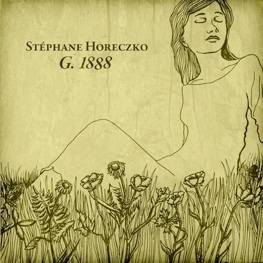Sheet Music from G. 1888
Stephane Horeczko’s sheet music is currently available as individual sheets and there is a package available of six of his pieces from
G. 1888. I will add reviews as more sheet music from
G. 1888 becomes available. Please see below for ordering and download information.
Quand la nuit s’evapore*
“Quand la nuit s’evapore” is the opening track on G. 1888 and is a bit longer and livelier than most of the tracks on the album. Expressive playing is a must even though playing the notes correctly is not difficult. The piece is composed in the key of G (one sharp) and alternates between 3/4 and 4/4 time. A very gentle and graceful piece, it will be a delight to play for pianists at an upper intermediate playing level. 4 pages
Fugaces (available here)*
“Fugaces” is the second track on Stephane Horeczko’s beautiful tribute to Erik Satie. This graceful piece is suitable for an intermediate-level pianist. Expressive playing is a must, but the piece is in E minor (one sharp) and an average-size hand should be able to reach all of the notes. This piece is played at a moderate tempo and the mood is one of gentle melancholy. Delicate and charming, it’s a lovely piece to play. 3 pages
G.1888*
“G. 1888” is track three and the title track of the album. Perhaps the piece that most emulates Erik Satie, it is very slow, dark, and uncomplicated. Played in a cool, stately manner, the timing is easy to understand and the notes are spare. There are several octave reaches, but pianists of an intermediate level should have no problem with it. 1 page
Paroles febriles (available here)
“Paroles febriles” is track four on the album. Built around variations on a repeated pattern, it has a very melancholy and introspective feeling. Composed in the key of A minor, it has a haunting quality. Coordinating both hands in a few places is a little tricky, but late-intermediate and early-advanced students should be able to handle those places quite easily with a little practice. 4 pages plus repeat
Absences*
“Absences” is the eighth track on G. 1888 and is almost heartbreaking in its simple loneliness. Playing the notes is very easy with this piece, but expression and emotion is required of the player. Composed in 12/8 time, the piece is made up of groups of flowing eighth notes - two on the left and one on the right. Played at a moderate speed and with a quiet voice, it is a short and easy piece to learn for pianists at an intermediate level. 1 page
Le songe d’Anastasia*
“Le songe d’Anastasia” is track nine of G. 1888 and is composed in a theme and variations form. Moderately slow and on the moody side, it is played in a fairly narrow range on the piano. An upper intermediate level pianist should be able to master this piece without much difficulty. 2 pages
Une epine et la beaute*
“Une epine et la beaute” is the twelfth and closing track on the album. Written as a duet for two pianos, the part for Piano 1 can be played with one hand. Piano 2 needs both hands and sounds fine by itself if a second pianist is not available. The piece is played slowly and expressively and changes key signatures several times. As long as the pianist playing the Piano 1 part is counting or is able to follow the Piano 2 part, this should be a fairly easy duet for intermediate or upper intermediate pianists. 2 pages
*A package that includes six of these pieces is available
here. That package includes “Quand la nuit s’evapore,” “Fugaces,” “G. 1888,” “Absences,” and “Le songe d’Anastasia” with the bonus of “Une epine et la beaute” for $10 USD.
Please see Stephane Horeczko’s
website for more information.

